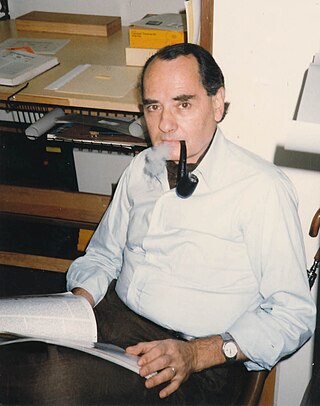Related Research Articles

Hagia Sophia, officially the Hagia Sophia Grand Mosque, is a mosque and former church serving as a major cultural and historical site in Istanbul, Turkey. The last of three church buildings to be successively erected on the site by the Eastern Roman Empire, it was completed in 537 CE. The site was a Greek Orthodox church from 360 CE to 1453, except for a brief time as a Latin Catholic church between the Fourth Crusade and 1261. After the fall of Constantinople in 1453, it served as a mosque until 1935, when it became a museum. In 2020, the site once again became a mosque.

James Mellaart FBA was an English archaeologist and author who is noted for his discovery of the Neolithic settlement of Çatalhöyük in Turkey. He was expelled from Turkey when he was suspected of involvement with the antiquities black market. He was also involved in a string of controversies, including the so-called mother goddess controversy in Anatolia, which eventually led to his being banned from excavations in Turkey in the 1960s. After his death, it was discovered that Mellaart had forged many of his "finds", including murals and inscriptions used to discover the Çatalhöyük site.

Cats is a sung-through musical with music by Andrew Lloyd Webber. It is based on the 1939 poetry collection Old Possum's Book of Practical Cats by T. S. Eliot. The musical tells the story of a tribe of cats called the Jellicles and the night they make the "Jellicle choice" by deciding which cat will ascend to the Heaviside Layer and come back to a new life. As of 2024, Cats remains the fifth-longest-running Broadway show and the seventh-longest-running West End show.

Sahure was a pharaoh of ancient Egypt and the second ruler of the Fifth Dynasty. He reigned for about 13 years in the early 25th century BC during the Old Kingdom Period. Sahure's reign marks the political and cultural high point of the Fifth Dynasty. He was probably the son of his predecessor Userkaf with Queen Neferhetepes II, and was in turn succeeded by his son Neferirkare Kakai.

Cleavage is the narrow depression or hollow between the breasts of a woman. The superior portion of cleavage may be accentuated by clothing such as a low-cut neckline that exposes the division, and often the term is used to describe the low neckline itself, instead of the term décolletage. Joseph Breen, head of the U.S. film industry's Production Code Administration, coined the term in its current meaning when evaluating the 1943 film The Outlaw, starring Jane Russell. The term was explained in Time magazine on August 5, 1946. It is most commonly used in the parlance of Western female fashion to refer to necklines that reveal or emphasize décolletage.

Benedict Timothy Carlton Cumberbatch is an English actor. Known for his work on screen and stage, he has received various accolades, including a BAFTA TV Award, a Primetime Emmy Award and a Laurence Olivier Award, in addition to nominations for two Academy Awards and four Golden Globes. In 2014, Time magazine named him one of the 100 most influential people in the world, and in 2015, he was appointed a CBE for services to performing arts and charity.
Slow Train to Izmir is a 2002 play written by Mark Angus. It has been performed at the Southwark Playhouse, where it was directed by Maggie Zolinsky. The play is based on a true story and focuses on the Anglo-Dutch archaeologist James Mellaart. In the late 1950s and early 1960s he was accused of, in turn, stealing an invaluable collection of Neolithic artefacts found near Dorak in Turkey and, ultimately, of fabricating their entire existence. The play deals with attempts by the Turkish press both to recover the treasure and to expose Mellaart and the western archaeology 'industry' as corrupt. The city mentioned in the title is İzmir, Turkey.

Mesut Özil is a German former professional footballer who played as an attacking midfielder. Known for his technical skills, creativity, passing skills, and vision, he is widely regarded as one of the greatest midfielders and playmakers of his generation. He could also play as a wide midfielder.
The Seljuk Empire, or the GreatSeljuk Empire, was a high medieval, culturally Turco-Persian, Sunni Muslim empire, established and ruled by the Qïnïq branch of Oghuz Turks. The empire spanned a total area of 3.9 million square kilometres from Anatolia and the Levant in the west to the Hindu Kush in the east, and from Central Asia in the north to the Persian Gulf in the south, and it spanned the time period 1037–1308, though Seljuk rule beyond the Anatolian peninsula ended in 1194.

Oscar White Muscarella was an American archaeologist and former Senior Research Fellow at the Metropolitan Museum of Art, where he worked for over 40 years before retiring in 2009. He specialized in the art and archaeology of the Ancient Near East, in particular Ancient Persia and Anatolia. Muscarella was an untiring opponent of the Looting of ancient sites and earned a reputation as the conscience of the discipline. He received his Ph.D. from the University of Pennsylvania in 1965.

Game of Thrones is an American fantasy drama television series created by David Benioff and D. B. Weiss for HBO. It is an adaptation of A Song of Ice and Fire, a series of fantasy novels by George R. R. Martin, the first of which is A Game of Thrones. The show premiered on HBO in the United States on April 17, 2011, and concluded on May 19, 2019, with 73 episodes broadcast over eight seasons.

This timeline of Russian innovation encompasses key events in the history of technology in Russia.

The Chelyabinsk meteor was a superbolide that entered Earth's atmosphere over the southern Ural region in Russia on 15 February 2013 at about 09:20 YEKT. It was caused by an approximately 18 m (59 ft) diameter, 9,100-tonne (10,000-short-ton) near-Earth asteroid that entered the atmosphere at a shallow 18.3 ± 0.4 degree angle with a speed relative to Earth of 19.16 ± 0.15 kilometres per second. The light from the meteor was briefly brighter than the Sun, visible as far as 100 km (60 mi) away. It was observed in a wide area of the region and in neighbouring republics. Some eyewitnesses also reported feeling intense heat from the fireball.
References
- ↑ Suzan Mazur, "Dorak Diggers Weigh in on Anna & Royal Treasure", www.scoop.co.nz from 4 August 2005
- ↑ Dora Jane Hamblin, Türkei – Land der lebenden Legenden, Bastei-Lübbe, Bergisch Gladbach 1975, ISBN 3-404-25012-5, S. 196 f.
- ↑ "James Mellaart: Pioneer…..and Forger" Popular Archaeology 11 Oct 2019